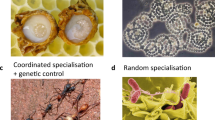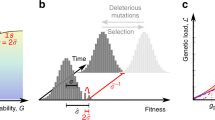Abstract
The division of labour, whereby individuals within a group specialize in certain tasks, has long been appreciated as central to the evolution of complex biological societies. In recent years, several examples of division of labour in microorganisms have arisen, which suggests that this strategy may also be important in microbial species. In this Opinion article, we explore the set of conditions that define division of labour and propose that cooperation between different phenotypes is a defining feature of division of labour. Furthermore, we discuss how clarifying what constitutes division of labour highlights key evolutionary questions, including what form division of labour takes and why it is favoured by natural selection.
This is a preview of subscription content, access via your institution
Access options
Subscribe to this journal
Receive 12 print issues and online access
$209.00 per year
only $17.42 per issue
Buy this article
- Purchase on Springer Link
- Instant access to full article PDF
Prices may be subject to local taxes which are calculated during checkout
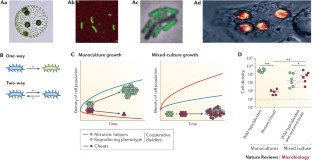
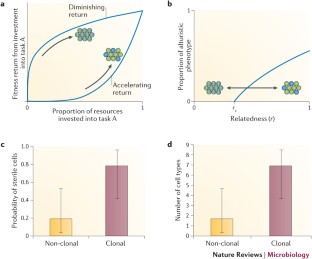
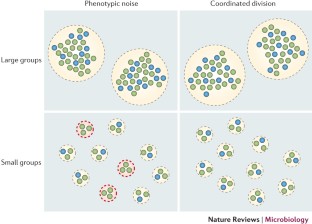
Similar content being viewed by others
References
Lewis, K. Persister cells, dormancy and infectious disease. Nat. Rev. Microbiol. 5, 48–56 (2006).
Veening, J.-W., Smits, W. K. & Kuipers, O. P. Bistability, epigenetics, and bet-hedging in bacteria. Annu. Rev. Microbiol. 62, 193–210 (2008).
Ackermann, M. A functional perspective on phenotypic heterogeneity in microorganisms. Nat. Rev. Microbiol. 13, 497–508 (2015).
Balaban, N. Q., Merrin, J., Chait, R., Kowalik, L. & Leibler, S. Bacterial persistence as a phenotypic switch. Science 305, 1622–1625 (2004).
Veening, J.-W. et al. Transient heterogeneity in extracellular protease production by Bacillus subtilis. Mol. Syst. Biol. 4, 1–15 (2008).
Claessen, D., Rozen, D. E., Kuipers, O. P., Søgaard-Andersen, L. & van Wezel, G. P. Bacterial solutions to multicellularity: a tale of biofilms, filaments and fruiting bodies. Nat. Rev. Microbiol. 12, 115–124 (2014).
van Gestel, J., Vlamakis, H. & Kolter, R. in Microbial Biofilms 2nd edn (eds Ghannoum, M., Parsek, M., Whiteley, M. & Mukherjee, P.) 67–97 (ASM press, 2015).
Ghoul, M., Griffin, A. S. & West, S. A. Toward an evolutionary definition of cheating. Evolution 68, 318–331 (2014).
Voelz, K. et al. 'Division of labour' in response to host oxidative burst drives a fatal Cryptococcus gattii outbreak. Nat. Commun. 5, 5194 (2014).
Maynard Smith, J. & Szathmáry, E. The Major Transitions in Evolution (Oxford Univ. Press, 1998).
Bourke, A. F. G. Principles of Social Evolution (Oxford Univ. Press, 2011).
West, S. A., Fisher, R. M., Gardner, A. & Kiers, E. T. Major evolutionary transitions in individuality. Proc. Natl Acad. Sci. USA 112, 10112–10119 (2015).
Crespi, B. J. & Yanega, D. The definition of eusociality. Behav. Ecol. 6, 109–115 (1995).
West, S. A., Griffin, A. S. & Gardner, A. Social semantics: altruism, cooperation, mutualism, strong reciprocity and group selection. J. Evol. Biol. 20, 415–432 (2007).
Tinbergen, N. On aims and methods of Ethology. Zeitschrift Tierpsychol. 20, 410–433 (1963).
Flores, E. & Herrero, A. Compartmentalized function through cell differentiation in filamentous cyanobacteria. Nat. Rev. Microbiol. 8, 39–50 (2009).
Davidson, C. J. & Surette, M. G. Individuality in bacteria. Annu. Rev. Genet. 42, 253–268 (2008).
West, S. A., Griffin, A. S., Gardner, A. & Diggle, S. P. Social evolution theory for microorganisms. Nat. Rev. Microbiol. 4, 597–607 (2006).
Hamilton, W. D. The genetical evolution of social behaviour. I. J. Theor. Biol. 7, 1–16 (1964).
Grafen, A. Optimization of inclusive fitness. J. Theor. Biol. 238, 541–563 (2006).
West, S. A. & Gardner, A. Adaptation and inclusive fitness review. Curr. Biol. 23, R577–R584 (2013).
Ackermann, M. et al. Self-destructive cooperation mediated by phenotypic noise. Nature 454, 987–990 (2008).
Diard, M. et al. Stabilization of cooperative virulence by the expression of an avirulent phenotype. Nature 494, 353–356 (2013).
Strassmann, J. E., Zhu, Y. & Queller, D. C. Altruism and social cheating in the social amoeba Dictyostelium discoideum. Nature 408, 965–967 (2000).
Velicer, G. J., Kroos, L. & Lenski, R. E. Developmental cheating in the social bacterium Myxococcus xanthus. Nature 404, 598–601 (2000).
Rainey, P. B. & Travisano, M. Adaptive radiation in a heterogeneous environment. Nature 394, 69–72 (1998).
Kim, W., Levy, S. B. & Foster, K. R. Rapid radiation in bacteria leads to a division of labor. Nat. Commun. 7, 10508 (2016).
Griffin, A. S., West, S. A. & Buckling, A. Cooperation and competition in pathogenic bacteria. Nature 430, 1024–1027 (2004).
Jiricny, N. et al. Fitness correlates with the extent of cheating in a bacterium. J. Evol. Biol. 23, 738–747 (2010).
Andersen, S. B., Marvig, R. L., Molin, S., Krogh Johansen, H. & Griffin, A. S. Long-term social dynamics drive loss of function in pathogenic bacteria. Proc. Natl Acad. Sci. USA 112, 10756–10761 (2015).
Diggle, S. P., West, S. A., Griffin, A. S. & Campbell, G. S. Cooperation and conflict in quorum-sensing bacterial populations. Nature 450, 411–414 (2007).
West, S. A., Winzer, K., Gardner, A. & Diggle, S. P. Quorum sensing and the confusion about diffusion. Trends Microbiol. 20, 586–594 (2012).
Ghoul, M., West, S. A., Diggle, S. P. & Griffin, A. S. An experimental test of whether cheating is context dependent. J. Evol. Biol. 27, 551–556 (2014).
van Gestel, J., Vlamakis, H. & Kolter, R. From cell differentiation to cell collectives: Bacillus subtilis uses division of labor to migrate. PLoS Biol. 13, e1002141 (2015).
Michod, R. E. Evolution of individuality during the transition from unicellular to multicellular life. Proc. Natl Acad. Sci. USA 104, 8613–8618 (2007).
Michod, R. E., Viossat, Y., Solari, C. A. & Hurand, M. Life-history evolution and the origin of multicellularity. J. Theor. Biol. 239, 257–272 (2006).
Ispolatov, I., Ackermann, M. & Doebeli, M. Division of labour and the evolution of multicellularity. Proc. Biol. Sci. 279, 1768–1776 (2012).
Gavrilets, S. Rapid transition towards the division of labor via evolution of developmental plasticity. PLoS Comput. Biol. 6, e1000805 (2010).
Oster, G. F. & Wilson, E. O. Caste and Ecology in the Social Insects (Princeton Univ. Press, 1978).
Charnov, E. L. The Theory of Sex Allocation (Princeton Univ. Press, 1982).
Koufopanou, V. & Bell, G. Soma and germ: an experimental approach using Volvox. Proc. R. Soc. B: Biol. Sci. 254, 107–113 (1993).
Rossetti, V. et al. The evolutionary path to terminal differentiation and division of labor in cyanobacteria. J. Theor. Biol. 262, 23–34 (2010).
Wilson, E. O. Ergonomics of caste in social insects. Am. Nat. 102, 41–66 (1968).
Koufopanou, V. The evolution of soma in the Volvocales. Am. Nat. 143, 907–931 (1994).
Herron, M. D., Hackett, J. D., Aylward, F. O. & Michod, R. E. Triassic origin and early radiation of multicellular volvocine algae. Proc. Natl Acad. Sci. USA 106, 3254–3258 (2009).
Solari, C. A., Kessler, J. O. & Michod, R. E. A. Hydrodynamics approach to the evolution of multicellularity: flagellar motility and germ–soma differentiation in volvocalean green algae. Am. Nat. 167, 537–554 (2006).
Solari, C. A., Ganguly, S., Kessler, J. O., Michod, R. E. & Goldstein, R. E. Multicellularity and the functional interdependence of motility and molecular transport. Proc. Natl Acad. Sci. USA 103, 1353–1358 (2006).
Wolf, J. B. et al. Fitness trade-offs result in the illusion of social success. Curr. Biol. 25, 1086–1090 (2015).
Gilbert, O. M., Foster, K. R., Mehdiabadi, N. J., Strassmann, J. E. & Queller, D. C. High relatedness maintains multicellular cooperation in a social amoeba by controlling cheater mutants. Proc. Natl Acad. Sci. USA 104, 8913–8917 (2007).
Mehdiabadi, N. J. et al. Kin preference in a social microbe. Nature 442, 881–882 (2006).
Kuzdzal-Fick, J. J., Queller, D. C., Fox, S. A. & Strassmann, J. E. High relatedness is necessary and sufficient to maintain multicellularity in Dictyostelium. Science 334, 1548–1551 (2011).
Bastiaans, E., Debets, A. J. M. & Aanen, D. K. Experimental evolution reveals that high relatedness protects multicellular cooperation from cheaters. Nat. Commun. 7, 1–10 (2016).
Fisher, R. M., Cornwallis, C. K. & West, S. A. Group formation, relatedness, and the evolution of multicellularity. Curr. Biol. 23, 1120–1125 (2013).
Maynard Smith, J. & Price, G. R. The logic of animal conflict. Nature 246, 15–18 (1973).
Dawkins, R. The Selfish Gene (Oxford Univ. Press, 1976).
Bonner, J. T. Cellular Slime Molds (Princeton Univ. Press, 1967).
Shelton, D. E., Desnitskiy, A. G. & Michod, R. E. Distributions of reproductive and somatic cell numbers in diverse Volvox (Chlorophyta) species. Evol. Ecol. Res. 14, 707–727 (2012).
Bell, G. & Mooers, A. O. Size and complexity among multicellular organisms. Biol. J. Linnean Soc. 60, 345–363 (1997).
Frank, S. A. Host–symbiont conflict over the mixing of symbiotic lineages. Proc. Biol. Sci. 263, 339–344 (1996).
Gore, J., Youk, H. & van Oudenaarden, A. Snowdrift game dynamics and facultative cheating in yeast. Nature 459, 253–256 (2009).
Ross-Gillespie, A., Gardner, A., West, S. A. & Griffin, A. S. Frequency dependence and cooperation: theory and a test with bacteria. Am. Nat. 170, 331–342 (2007).
Haig, D. Weismann rules! OK? Epigenetics and the Lamarckian temptation. Biol. Philos. 22, 415–428 (2006).
Maynard Smith, J. Group selection. Q. Rev. Biol. 51, 277–283 (1976).
Gordon, D. M. From division of labor to the collective behavior of social insects. Behav. Ecol. Sociobiol. 70, 1101–1108 (2015).
Rainey, P. B. & Kerr, B. Cheats as first propagules: a new hypothesis for the evolution of individuality during the transition from single cells to multicellularity. Bioessays 32, 872–880 (2010).
Hammerschmidt, K., Rose, C. J., Kerr, B. & Rainey, P. B. Life cycles, fitness decoupling and the evolution of multicellularity. Nature 515, 75–79 (2015).
Veening, J.-W. et al. Bet-hedging and epigenetic inheritance in bacterial cell development. Proc. Natl Acad. Sci. USA 105, 4393–4398 (2008).
Kirk, D. L. Asymmetric division, cell size and germ–soma specification in Volvox. Semin. Dev. Biol. 6, 369–379 (1995).
Schmitt, R. Differentiation of germinal and somatic cells in Volvox carteri. Curr. Opin. Microbiol. 6, 608–613 (2003).
Nedelcu, A. M. & Michod, R. E. The evolutionary origin of an altruistic gene. Mol. Biol. Evol. 23, 1460–1464 (2006).
Hanschen, E. R., Ferris, P. J. & Michod, R. E. Early evolution of the genetic basis for soma in the Volvocaceae. Evolution 68, 2014–2025 (2014).
Fisher, R. A. The Genetical Theory of Natural Selection (Clarendon, 1930).
Grafen, A. The formal Darwinism project: a mid-term report. J. Evol. Biol. 20, 1243–1254 (2007).
Leigh, E. G. When does the good of the group override the advantage of the individual? Proc. Natl Acad. Sci. USA 80, 2985–2989 (1983).
Gardner, A. & Grafen, A. Capturing the superorganism: a formal theory of group adaptation. J. Evol. Biol. 22, 659–671 (2009).
Shelton, D. E. & Michod, R. E. Philosophical foundations for the hierarchy of life. J. Evol. Biol. 25, 391 (2010).
Sturm, A. et al. The cost of virulence: retarded growth of Salmonella Typhimurium cells expressing type III secretion system 1. PLoS Pathog. 7, e1002143 (2011).
Acknowledgements
The authors thank K. Boomsma, A. P. Escudero, K. Foster, A. Gardner, M. Ghoul, J. Gore, A. Griffin, R. May, J. Strassmann, D. Unterweger and J. van Gestel for very useful discussions. The authors also thank M. Ackermann, R. May, R. Michod and J.-W. Veening for kindly providing images. G.A.C was funded by the Engineering and Physical Sciences Research Council (EPSRC).
Author information
Authors and Affiliations
Corresponding author
Ethics declarations
Competing interests
The authors declare no competing financial interests.
Supplementary information
Supplementary information S1 (box)
Intentional Language and Adaptation (DOC 40 kb)
Supplementary information S2 (box)
The Mutation Test (DOC 25 kb)
Supplementary information S3 (box)
Different Types of Division (DOC 30 kb)
Supplementary information S4 (box)
Graphing Efficiency Benefits (DOC 27 kb)
Supplementary information S5 (box)
Can You Get Division of Labour Between Species? (DOC 44 kb)
Supplementary information S6 (box)
Variation in Mechanism Within Species (DOC 29 kb)
Supplementary information S7 (box)
Selection Versus Adaptation (DOC 28 kb)
Supplementary information S8 (box)
Can Bet-Hedging be Cooperative? (DOC 28 kb)
Supplementary information S9 (box)
Can You Get Division of Labour With Spiteful Traits? (DOC 30 kb)
Rights and permissions
About this article
Cite this article
West, S., Cooper, G. Division of labour in microorganisms: an evolutionary perspective. Nat Rev Microbiol 14, 716–723 (2016). https://doi.org/10.1038/nrmicro.2016.111
Published:
Issue Date:
DOI: https://doi.org/10.1038/nrmicro.2016.111
This article is cited by
-
Task-specific odorant receptor expression in worker antennae indicates that sensory filters regulate division of labor in ants
Communications Biology (2023)
-
Exogenous microorganisms promote moss biocrust restoration and shape microbiomes in a sandy desert
Plant and Soil (2023)
-
Dynamic altruistic cooperation within breast tumors
Molecular Cancer (2023)
-
Integrase-mediated differentiation circuits improve evolutionary stability of burdensome and toxic functions in E. coli
Nature Communications (2022)
-
Resource sharing is sufficient for the emergence of division of labour
Nature Communications (2022)

